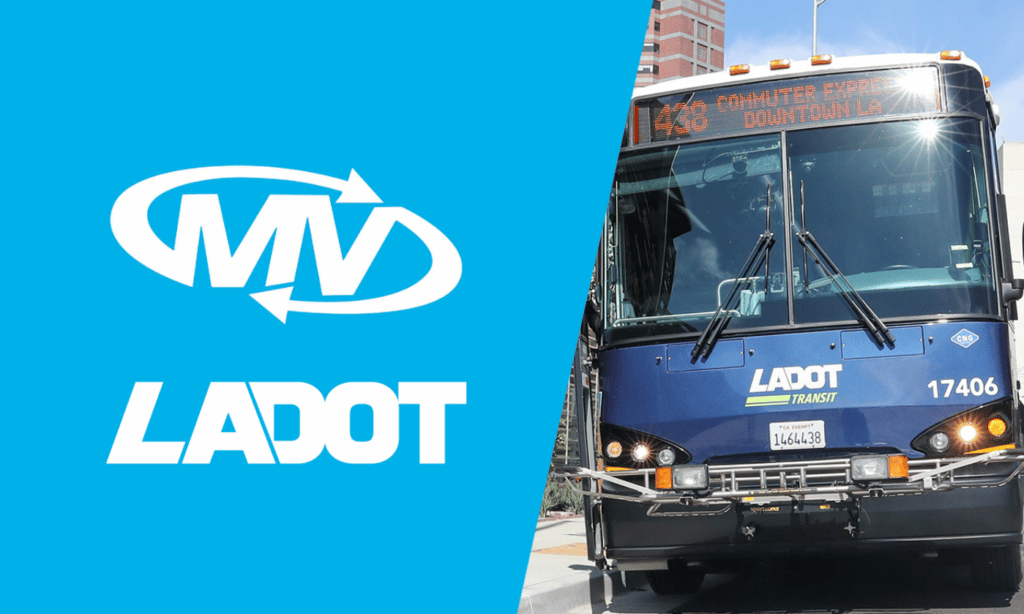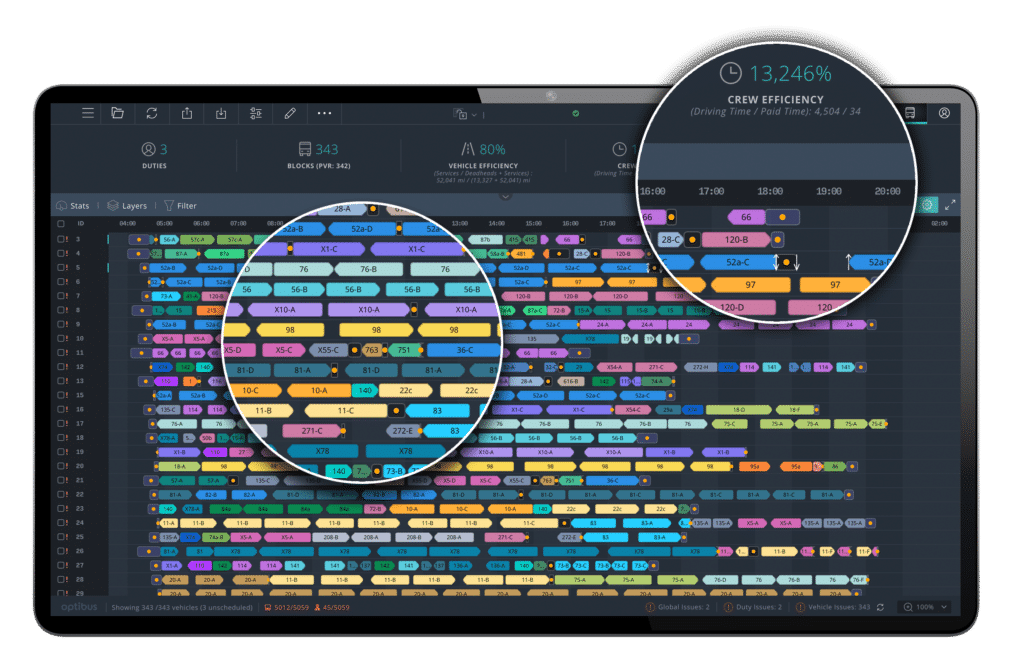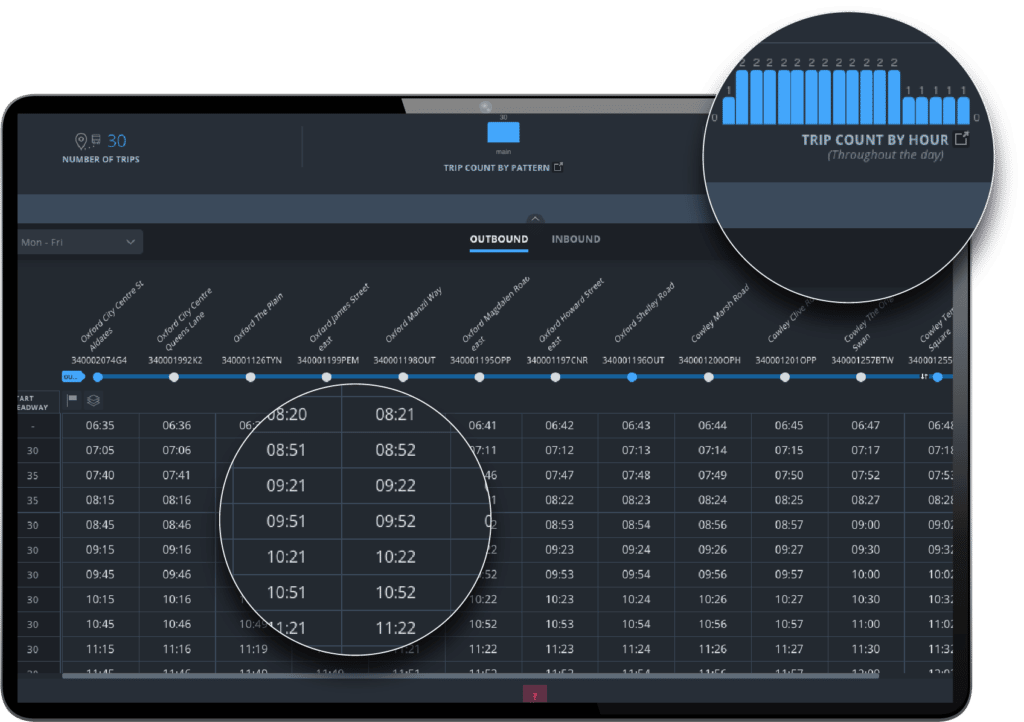Overview
Private transportation operators working with public agencies are increasingly required to use intelligent transport systems (ITS) like Optibus to fulfill RFP criteria and deliver services. Familiarity with such software gives PTOs an edge on the competition towards winning the RFP, and when PTAs and PTOs use the same ITS for planning and scheduling, it enhances communication, collaboration, and service quality.
This case study examines how MV Transportation and the Los Angeles Department of Transportation (LADOT) improve their work processes and speed by both working off Optibus’ software.

Background
MV Transportation is the largest privately-owned passenger transportation contracting firm in the United States, working with over 200 city and county transit agencies, school districts, universities, and corporations and serving over 110 million passengers each year. The operator has used Optibus since 2017 and built its fixed-route scheduling practice around the use of our platform. Today, MV uses Optibus to schedule over 1,500 buses across the US and Canada.
LADOT is one of the public transportation agencies leading transportation planning, project delivery, and operations in the City of Los Angeles, delivering over 19 million annual trips.
Together, LADOT and MV have pioneered the collaborative operator-agency approach by having Optibus in use by both LADOT’s planners and MV’s schedulers. This strategy has cut days off the planning process by reducing back and forth communication around data validation. It also reinforces a strong partnership through smoother collaboration and better insight into partners’ work processes, resulting in fewer errors, more realistic client expectations, and better services for passengers.
Jacob Brothers, Enhanced Technology Program Coordinator at LADOT
Challenges and Results
Streamlining data validation with single source of information
Data validation is crucial in ensuring quality services and a successful partnership. Operators need to ensure that every trip starts when it is supposed to and that headways and runtimes are correct at all times. However, manually checking every time point of every stop for errors can be a time-consuming task.
Liz Stayner, Senior Transit Planning Manager at MV, explains that when working with an agency that uses GTFS or that stores data in a manual or legacy system, “there’s a lot of additional time that’s spent validating it to make sure there were no errors in the data source and everything matches what it should match.”
Things get even more complicated if an agency works with a third party to generate GTFS data.
“We’re talking about data that’s gone from one system into another and it’s now going into a third. If there’s a blank line or a time isn’t correct in a time point in the 57th trip of the day, you don’t see that until you’re doing a true stare and compare,” said Liz.
Liz estimates that data validation takes several days when the operator and agency use different platforms. Jacob Brothers, Enhanced Technology Program Coordinator at LADOT, said that using multiple platforms doubled LADOT’s workload and forced them to review data “line by line, having to figure out what’s wrong with the feed before it will import,” even for minor errors.
By conducting all work within Optibus’ platform, MV and LADOT avoided those hurdles.
“When all of your data is in one space, there’s not as much time to spend in data validations and conversions and imports, so it’s a quicker work stream than if we’re using multiple platforms. So when we get the data from LADOT, it’s all ready,” said Liz.
Using Optibus, MV sources their data directly from LADOT. LADOT sends MV the data through the Optibus platform, and MV easily imports the JSON file from LADOT’s domain into their own. The data arrives in the correct format and there are no concerns about data validation because there haven’t been any conversions.
“When it’s built in the same system, you don’t have the frequency of errors because it hasn’t gone into three different formats since it was created,” said Liz. “I know it’s a clean dataset for us to start working with.”

Liz Stayner, Senior Transit Planning Manager at MV Transportation
Saving time by staying aligned
Liz estimates that if MV and LADOT were not both using Optibus, each service change would cause a setback of “probably several days” between all the emails, phone calls, and screen sharing sessions that would be needed to replicate work on both the operator’s and agency’s systems.
“They have to verify that what I found is correct and then make changes on their side. We either make the changes on our side as well or we get new data. It’s definitely not something that is caught or able to be handled as quickly as when you’re working in the same system,” says Liz.
Working off the same files and data in Optibus means LADOT and MV skip the back and forth and avoid miscommunication, enabling Liz and her team to save as many as three days of work time.
“We have never had anything like Optibus before,” said Jacob. “For sure there were huge time savings.”
Liz Stayner, Senior Transit Planning Manager at MV Transportation

Working better, together, and better independently
Optibus enables LADOT and MV to work collaboratively when support is needed, and independently when tasks can be completed more effectively alone.
In some cases, LADOT creates a schedule and sends it to MV to build within Optibus. MV sets the headways, conducts blocking, and ensures that scheduling aligns with vehicle availability.
“Within the [Optibus] timetable, you can see what blocking would look like [using Vehicle View],” said Liz. “For the planners who are developing the schedules to have that capability and not have to go into the vehicle schedule to see what the capital needs are going to be for that particular service, that’s been quite cool.”
“In the past, [scheduling] was something that was done once it came to me. Once I am creating the vehicle schedules, if we find one of these issues, we then have the conversation [with LADOT], make the change, adjust it in the vehicle schedule. But now, the agency can see it before it goes to the scheduling part of the planning process.”
“If there’s no scheduling changes, we are just moving a stop, we as an agency could push that out rather than waiting for MV,” said Jacob.
“It really makes the entire process easier and I think we’re better able to be true partners [with the agency] when we are using the same system,” said Liz. “There may be something that they’re looking to do and maybe they don’t know or understand how to do something that I can help them with – and vice versa. If they’re in the system, they see something, they can make a quick change and don’t have to rely on me to do it. I think it’s mutually beneficial for everybody when we’re working in the same environment.”
Jacob emphasized the value of being able to hop into Optibus and “eliminate that part of having [Liz] invest in it and just put out that feed ourselves.”
LADOT can manage that work independently – and without worrying that they will disrupt MV’s work – because Optibus helps LADOT catch errors in the advanced stages.
“[Optibus] won’t allow us to schedule two trips at the same time,” Jacob explains. “This is a multi-level check to make sure the data is clean, our schedules match, and they make sense.”
Liz Stayner, Senior Transit Planning Manager at MV Transportation
Staying on the same page by using the same software
When partners use different or unfamiliar platforms to plan and deliver services, they compromise the insight and understanding needed to form a strong, successful partnership.
Because both LADOT and MV are familiar with Optibus and use the platform collaboratively to plan and deliver services, the agency and operator gain insight into each other’s work, making it easier to manage expectations and form trust and understanding.
“The agency understands what we’re doing and they understand the tools that we’re using. So I think there’s more realistic expectations on both sides of how long a process takes and what steps are needed,” Liz explained. “They know what a realistic timeline looks like for moving the data from, ok, the schedule has been designed and we know how long it is going to take to finish developing the schedule to having it operational.”
- MV Transportation
- 14,000 employees
- 10,000 vehicles
- Modules Used: Planning, Scheduling, EV Management, Rostering, Analytics
- Public transportation operator